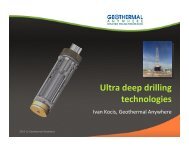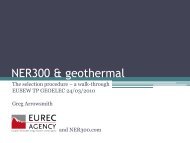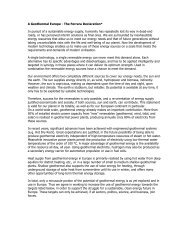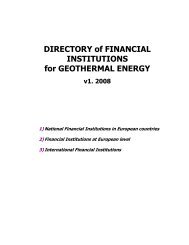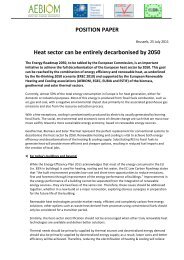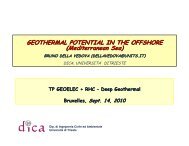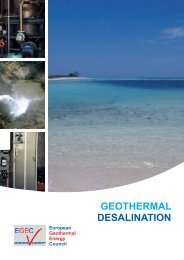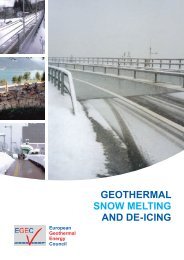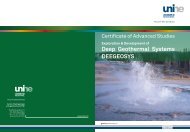Strategic Research and Innovation Agenda for Renewable ... - EGEC
Strategic Research and Innovation Agenda for Renewable ... - EGEC
Strategic Research and Innovation Agenda for Renewable ... - EGEC
You also want an ePaper? Increase the reach of your titles
YUMPU automatically turns print PDFs into web optimized ePapers that Google loves.
<strong>Renewable</strong>Heating & CoolingEuropean Technology Plat<strong>for</strong>mSt<strong>and</strong>ardisation <strong>and</strong> quality assuranceThe market penetration of RHC technologies depends on the capacity of the EU industry toprovide innovative solutions, to gain the trust of consumers <strong>and</strong> to address in<strong>for</strong>mation barriers.The market <strong>for</strong> heating <strong>and</strong> cooling systems is characterised by asymmetricin<strong>for</strong>mation. Policies are required that ensure that prospective customers are provided withst<strong>and</strong>ardised in<strong>for</strong>mation about the technological solution that best meets thethermal energy needs of the individual building, district or industrial process. This is of specialimportance <strong>for</strong> small- <strong>and</strong> large-scale hybrid systems 79 . The market penetration of efficienthybrid systems could be supported by improving energy per<strong>for</strong>mance labels, which shouldbe required <strong>for</strong> all new heating <strong>and</strong> cooling systems in the EU by 2020. The in<strong>for</strong>mationprovided should not only include the relative efficiency, but also the annual running cost,greenhouse gas emissions <strong>and</strong> the expected system lifetime.St<strong>and</strong>ardisation is needed to ensure quality to the market but should not becomean obstacle to the introduction of new products. In parallel with system development,new st<strong>and</strong>ards should be developed which are able to characterise not only the thermalper<strong>for</strong>mance but also the quality <strong>and</strong> expected lifetime of a RHC application.The following priorities are identified:• Development of accelerated ageing tests <strong>for</strong> collectors <strong>and</strong> collector materials.• St<strong>and</strong>ardised testing methods <strong>and</strong> assessment procedures <strong>for</strong> controller-dependentbehaviour of system components.• Elaboration of st<strong>and</strong>ards <strong>for</strong> the hydraulic <strong>and</strong> electrical interconnections of differentbuilding components.• St<strong>and</strong>ardised electrical interfaces defined <strong>for</strong> the interconnection of different sensors <strong>and</strong>actuators to the control system.• A st<strong>and</strong>ard set of tests <strong>for</strong> hybrid systems should be developed to certify their thermal <strong>and</strong>electrical efficiency <strong>and</strong> CO 2 emissions.• New labelling or certification st<strong>and</strong>ards need to be developed to evaluate <strong>and</strong> comparenew thermal energy storage materials <strong>and</strong> applications as they will become available onthe market.• St<strong>and</strong>ardisation of the in<strong>for</strong>mation provided to the consumer through improved energyper<strong>for</strong>mance labels.79In fact in hybrid systems theefficiency of a single componentis of relative importance<strong>and</strong> gives only limited in<strong>for</strong>mationon the per<strong>for</strong>manceof the overall system. Inorder to support the marketpenetration of innovative <strong>and</strong>low-emissions of hybrid systems,customers ought to betransparently in<strong>for</strong>med on theefficiency of the entire system<strong>and</strong> they should have the possibilityto compare systemswith different components ina direct way. There<strong>for</strong>e st<strong>and</strong>ardisedtesting proceduresare needed <strong>and</strong> laboratoriesshould test energy systemsfollowing harmonised procedures<strong>and</strong> cycles.80In many residential <strong>and</strong>non-residential buildingsthose who pay the bill arenot the decision-makers oninfrastructure investments.Owners have to be encouragedto make the necessaryinvestments <strong>and</strong> to be ableto benefit from the measuresimplemented.Development of new business models<strong>Renewable</strong> energy technologies such as solar thermal <strong>and</strong> geothermal energy havelow running costs but require a high upfront investment. New business models mustbe developed to overcome the barrier of financing upfront costs. Measures to overcome the“owner-tenant dilemma” 80 are needed <strong>for</strong> the sector to reach its full potential, inparallel with innovative schemes <strong>for</strong> outsourcing technical <strong>and</strong> economic risks, <strong>and</strong>offering further energy related services such as those offered by ESCOs.New strategies are needed <strong>for</strong> technology suppliers <strong>and</strong> stakeholders of related sectors(such as building owners) aiming at facilitating access to capital, financing of upfront costs,outsourcing technical <strong>and</strong> economic risks, <strong>and</strong> including the offer of energy related services.Innovative marketing strategies should be elaborated based on market research tostimulate the refurbishment of the existing building stock <strong>and</strong> heating systems with modernRHC technology.In the district heating <strong>and</strong> cooling sector, today’s business models are based on thequantity of heat or cold transported as the expansion of the grid has resulted in the ability toserve more customers. Tomorrow’s DHC business will be more complex, offeringa broader range of services that should be managed simultaneously, including storage<strong>and</strong> cooling, <strong>and</strong> the feed-in of heat or cold from the entities connected to its network.With the advent of low-energy houses, each customer will consume less heat. Moreover,some consumers will produce their own heat <strong>and</strong> will store or deliver their surplus to thethermal energy grid or directly to other buildings. All these aspects will lead to a new way ofoperating the networks, allowing less investment in the production side <strong>and</strong> a smootherdelivery flow, <strong>for</strong> the benefit of the energy system <strong>and</strong> its customers. The DHC industry willneed to adopt new business models to remain profitable even if less heat is sold.81



